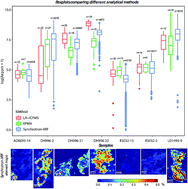Using multiple micro-analytical techniques for evaluating quantitative synchrotron-XRF elemental mapping of hydrothermal pyrite†
Abstract
Pyrite (FeS2) elemental composition can be used as an indicator of hydrothermal fluid evolution both in low and high temperature environments. Synchrotron scanning X-ray fluorescence is an efficient, non-destructive, imaging technique that can be used to map heterogeneous pyrite elemental composition with excellent spatial resolution. The accuracy of quantified synchrotron-XRF elemental mapping relative to other widely trusted analytical techniques has not been previously evaluated for geologically relevant minerals such as pyrite. This study used pyrite samples from the Candelaria-Punta del Cobre Iron Oxide Copper Gold (IOCG) district in northern Chile to assess synchrotron scanning XRF as both an imaging method and quantitative analytical tool for observing local variations in pyrite chemistry. The results were quantified relative to a well-characterized pyrite sample as a standard. In order to evaluate the reliability of synchrotron-XRF as a quantitative tool, relative to laser ablation inductively coupled plasma mass spectrometry and electron probe micro-analyses, all three analyses were completed on the same pyrite grains and statistical tests were performed comparing data for Co, Ni, As and Se from all three analytical techniques. An overall strong positive correlation between the datasets was observed. The accuracy and reliability of the quantitative synchrotron-XRF results are strongly dependent on careful data processing. In the case of pyrite, peak overlaps between Co, Fe and Cu ultimately required a multistep approach to define spatial distributions and then derive accurate Co concentrations. Initial, consistently high concentrations of Co in the synchrotron-XRF data, arising from Fe Kβ/Co Kα peak overlap, were mitigated by fitting only the Co Kβ line. Our results indicate that synchrotron-XRF is a reliable tool for acquiring quantitative accurate chemical data from geological specimens.



 Please wait while we load your content...
Please wait while we load your content...